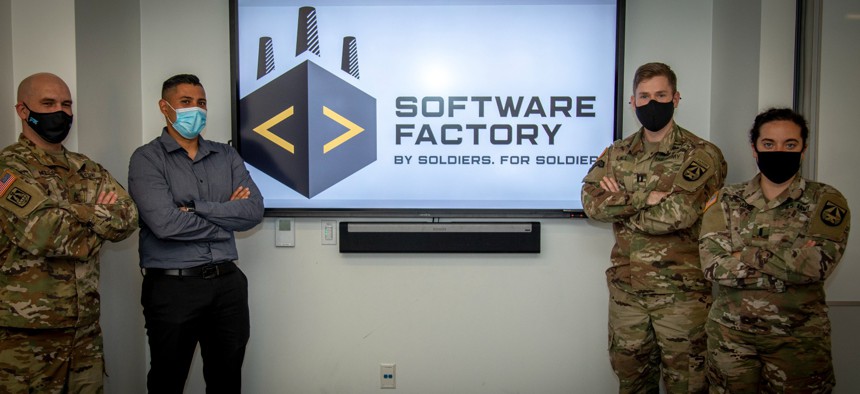
Army Futures Command's software factory in Austin, Texas U.S. Army Photo by Mr. Luke J. Allen
The Army's Top Buyer Wants to Test the Limits of Flexible Software Spending
Douglas Bush, the Army's newly confirmed acquisition chief, wants to do more to reform how the service buys and sustains software.
To improve how the Army funds software, the military branch's new chief weapons buyer wants things to be as flexible as possible–within certain limits.
Douglas Bush, the Army's newly confirmed acquisition chief, told reporters Feb. 17 that while he doesn't yet have a "master plan" for accelerating how the service buys and funds software development, he wants to devise one focused on using flexible authorities.
Bush, who was a longtime congressional staffer, said he thinks the Army has the authorities it needs from Congress and that it's "a question of using them well." That includes other transaction authorities, which can help the Defense Department more quickly engage small businesses and tweak contract needs as they arise. But the main concern is being able to monitor their use.
"The primary issue is we have to make sure we have sufficient transparency and all the metrics Congress would expect us to have to know how those contracts are performing," including cost trends or progress, he said. And while "broadly pleased" with how the Army is currently using OTAs, Bush said some oversight work needed to make sure they're being used responsibly.
Additionally, the Army's top buyer wants to explore the Defense Department's colorless money pilot for software that's often referred to as Budget Activity 8 or BA-08 programs. The Army currently has a program focused on defensive cyber software development enrolled, but Bush wants to do more.
"We certainly need to, to the extent we can, further explore the BA-08 flexible funding pilot to show what we can do and maybe open the aperture with Congress for more authority and that way," said Bush, who also noted that reimagining how to budget for software would be critically important.
"For example, I don't believe the private sector distinguishes between [research and development] and procurement of software. But we do. So does that make sense anymore? I'm not so sure."
In response to policy questions for his nomination hearing Bush listed capitalizing on cloud and data technologies as his top software priority because it "enables the Army to separate software and IT development from the management of hosting infrastructure, offering the opportunity to do both more efficiently, while also allowing the Army to leverage data to improve decision making, automate processes, and gain insights that would have otherwise gone unknown.
Reforming software development approaches was number two.
"We also have significant gaps in the software area. The Army needs to recognize that software is growing exponentially and develop strategies, skills and expertise to properly manage software intensive programs throughout the acquisition system lifecycle with a keen eye on reducing operational and sustainment costs," he wrote.
"In the area of software, the Army has struggled at times to keep programs on budget and on schedule, often due to unclear requirements work up front or requirements creep during software development. In all these cases, I have found that the Army can find a path to success when the problems are clearly understood and all the appropriate stakeholders, including Congress, are involved in finding solutions," Bush told lawmakers.
Bush also previewed that he would lean on the Defense Department's software acquisition pathway to accelerate that change.
"We have six software efforts that are in that new [software] acquisition pathway. They're smaller efforts. We're hoping to learn from those," Bush told reporters.
The subject, he said, will be "an ongoing discussion with Congress in terms of how we're using that authority and whether they're comfortable with a different approach where some funding might have to be more flexible, to allow us to do it that way versus the more traditional approach."
But the new chief noted that flexible funding didn't necessarily mean looking for more money to buy software.
"There's efforts underway to look at enterprise business systems to try to achieve savings while modernizing. So I wouldn't say it's an area where there might be more money. Because there's already a lot of money," Bush said.







